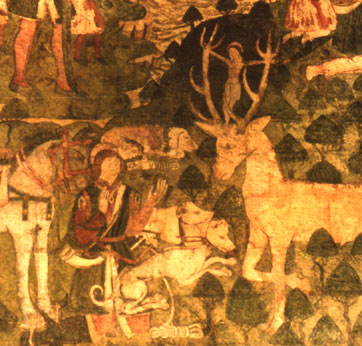Eustace
This legendary 2nd-century Christian martyr's story is told in Chapter 14. Also known as Eustatius or Eustachio, he reportedly began as a Roman soldier named Placidus, who converted to Christianity after seeing a vision of Christ between the antlers of a stag. He was then tested by the loss of his family in a series of tragic misadventures (including losing his sons to a wolf and a lion while trying to cross a river), but they were restored to him and he achieved honor in the Roman army before being martyred for his faith. He is a patron saint of hunters*.
However, the entire story may be apocryphal, and Eustace is not recognized by the Anglican nor the Catholic Church. There are many unrelated saints of the same name: Eustace of Vilna, Eustathius Bishop of Antioch, Eustace of Luxeuil, etc.
The vision of the stag is commonly thought to be a borrowing from pre-Christian mythology. In Celtic myth, a white stag appears when the hero is called to a quest, or has entered a magical or forbidden realm. In the Welsh Mabinogion, the prince Pwyll accidentally trespasses on a hunt led by Arawn, lord of the underworld, who is hunting a white stag; Arawn's hunting hounds also pursue the souls of the damned.
Hungarian legend includes a mystical stag, son of a horned doe who carries the sun between her horns. In an origin myth of the Huns and Magyars, the Legend of the Hind, a king goes on a hunt for this doe accompanied by his twin sons, who are separated from their father along the way.
* The stag-and-cross logo on Jägermeister liqueur (Jäger means hunter) is not actually a reference to Eustace, but to Saint Hubert, whose conversion story is identical and was probably borrowed from the earlier legend.
Mural at Canterbury

The Eustace painting in Canterbury Cathedral, by an unknown artist from about 1480 AD, is on a wall panel about nine feet high in the north choir—hard to see well from below, with its patchy colors in dim light, but still strikingly detailed.

The story starts at the bottom, and ends at the top with the martyrdom in the brazen bull. At left is a detail from the beginning, showing Eustace's vision of a miniature Christ.
At the dead center of the painting is Eustace standing in water, as his sons are carried away on either side by a wolf and a lion—shown below in a somewhat clearer redrawn version of the painting by E.W. Tristram, which is on display on the facing wall.
Hoban writes in his afterword: "Eustace is all alone in the middle of the river, hoping for better times. Seeing him for the first time that day in 1974 I had a strong fellow-feeling." EE

See also
- Story from The Golden Legend or Lives of the Saints (1275)
- earliest known reference
- Story from Sacred and Legendary Art, 1911
- "there is nothing in this legendary romance to recommend it"
- Legends of the Saints
- essay on the gray area between hagiography and myth
- St. Eustachius by Anselm Kiefer
- done in 1974, the same year Hoban encountered the painting in Canterbury DO
- St. Eustace's Well
- this is right next to How Fents